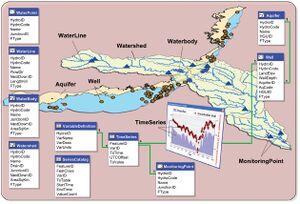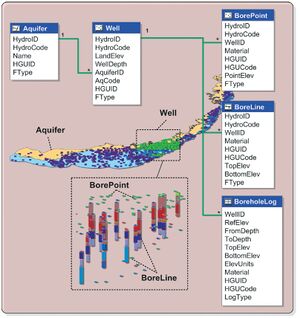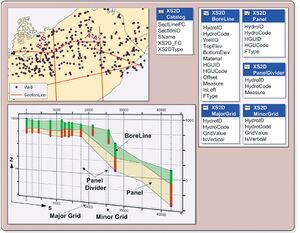Revision as of 23:39, 9 September 2019
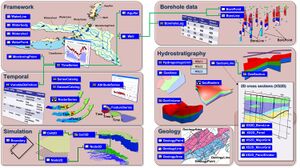
Overview diagram of the Arc Hydro Groundwater Data Model
Arc Hydro Groundwater is a geodatabase design for representing groundwater datasets within ArcGIS. The data models helps archive, display, and analyze multidimensional groundwater data, and includes several components to represent different types of datasets including representations of aquifers and wells/boreholes, 3D hydrogeologic models, temporal information, and data from simulation models. The data model is compatible with the surface water data model and will share the same framework.
Background
The Arc Hydro data model started as a data model for representing surface water systems within an ArcGIS geodatabase. In 2002 the Arc Hydro data model was published as an ESRI book entitled: Arc Hydro GIS for Water Resources. Arc Hydro has been highly successful and has been widely adopted in industry. The groundwater data model has been developed as a companion to the surface water data model. The data model is based on a newly designed Arc Hydro framework which is shared by the surface water and groundwater data models. Users can add groundwater and surface water components to the framework as necessary, or develop their own components. This new componentized approach enables tailoring the geodatabase design to meet specific project needs. Each component of Arc Hydro Groundwater data model is described below.
The groundwater data model is being documented as an ESRI Press book: Arc Hydro Groundwater Data Model, which will be available in the coming months.
This wiki compliments the book but is not a replacement for it.
Framework Component
The Arc Hydro framework provides a simple data structure for storing basic spatial datasets describing hydrologic systems. The framework supports basic water resources analysis such as tracing water as it flows over the terrain in watersheds, streams, and water bodies, creating groundwater level and groundwater quality maps, and viewing time series data related with monitoring stations and wells.
- Aquifer – Polygon features representing aquifer boundaries. The features can be classified to represent different zones such as outcrop and confined sections of the aquifer.
- MonitoringPoint – Point features representing locations where hydrologic variables are measured, such as stream-gage stations and precipitation gages.
- SeriesCatalog – Table for indexing and summarizing time series stored in the TimeSeries table.
- TimeSeries – Table for storing time varying data such as water levels, flow, and water quality.
- VariableDefinition – Table for storing time series values.
- WaterBody – Polygon features representing areas such as ponds, lakes, swamps, and estuaries.
- WaterLine – Line features representing hydrographic “blue lines”, which represent mapped streams and water body center lines.
- WaterPoint – Point features representing hydrographic features such as springs, water withdrawal/discharge locations, and structures.
- Watershed – Polygon features representing drainage areas contributing water flow from the land surface to the water system.
- Well – Point features representing well locations and their attributes.
 Aquifer Aquifer
|
| Polygon Feature Class
|
| Field name
|
Type
|
Description
|
| HydroID |
Long Integer |
Unique feature identifier in the geodatabase used for creating relationships between classes of the data model.
|
| HydroCode |
Text |
Permanent public identifier of the feature used for relating features with external information systems.
|
| Name |
Text |
Text attribute representing the name of the aquifer.
|
| HGUID |
Long Integer |
Relates aquifer polygons with more detailed descriptions of hydrogeologic units defined in the HydrogeologicUnit table.
|
| FType |
Text |
Distinguishes between types of aquifers or zones within an aquifer (e.g., unconfined and confined).
|
 MonitoringPoint MonitoringPoint
|
| Point Feature Class
|
| Field name
|
Type
|
Description
|
| HydroID |
Long Integer |
Unique feature identifier in the geodatabase used for creating relationships between classes of the data model.
|
| HydroCode |
Text |
Permanent public identifier of the feature used for relating features with external information systems.
|
| Name |
Text |
Text attribute representing the name of the aquifer.
|
| JunctionID |
Long Integer |
Relates a MonitoringPoint feature with a river network by associating the point feature with a junction on the network. The JunctionID of MonitoringPoint feature is equal to the HydroID of a related HydroJunction feature.
|
| FType |
Text |
Distinguishes between types of monitoring points (e.g., stream and precipitation gages, water quality monitoring sites).
|
 SeriesCatalog SeriesCatalog
|
| Table
|
| Field name
|
Type
|
Description
|
| FeatureID |
Long Integer |
Unique feature identifier. Is equal to the HydroID of the feature associated with the time series summarized in the catalog.
|
| FeatClass |
Text |
Name of the feature class to which the related feature belongs.
|
| VarID |
Long Integer |
Numerical identifier for the variable within the geodatabase. Matches the HydroID of the associated record in the VariableDefinition table.
|
| TsTable |
Text |
Table containing the time series record.
|
| StartTime |
Date |
The start date/time value of the series.
|
| EndTime |
Date |
The end date/time value of the series.
|
| ValueCount |
Long Integer |
Number of time-series values in the series.
|
 TimeSeries TimeSeries
|
| Table
|
| Field name
|
Type
|
Description
|
| FeatureID |
Long Integer |
Unique feature identifier. Is equal to the HydroID of the feature associated with the time series value.
|
| VarID |
Long Integer |
Numerical identifier for the variable within the geodatabase. Matches the HydroID of the associated record in the VariableDefinition table.
|
| TsTime |
Date |
Time stamp specifying the date and time associated with the time series value.
|
| UTCOffset |
Double |
Number of hours the time coordinate system used to define TsTime is displaced from Coordinated Universal Time.
|
| TsValue |
Double |
Numerical value of the variable at the given location and time.
|
 VariableDefinition VariableDefinition
|
| Table
|
| Field name
|
Type
|
Description
|
| VarID |
Long Integer |
Unique numerical identifier for the variable within the geodatabase.
|
| VarName |
Text |
The name of the variable.
|
| VarDesc |
Text |
The description of the variable.
|
| VarUnits |
Text |
Units of measure for the variable.
|
 WaterBody WaterBody
|
| Polygon Feature Class
|
| Field name
|
Type
|
Description
|
| HydroID |
Long Integer |
Unique feature identifier in the geodatabase used for creating relationships between classes of the data model.
|
| HydroCode |
Text |
Permanent public identifier of the feature used for relating features with external information systems.
|
| Name |
Text |
Text attribute representing the name of the water body.
|
| JunctionID |
Long Integer |
Relates a WaterBody feature with a river network by associating a water body with a junction on the network. The JunctionID of a WaterBody feature is equal to the HydroID of a related HydroJunction feature.
|
| NextDownID |
Long Integer |
Relates a WaterBody feature to its downstream feature, thus creating feature to feature connectivity. NextDownID of a WaterBody feature is equal to the HydroID of the next downstream feature.
|
| AreaSqKm |
Double |
Area of the WaterBody feature in square km units. This attribute is commonly used for modeling purposes and analytic calculations.
|
| FType |
Text |
Distinguishes between types of water bodies (e.g., lake, pond, and estuary).
|
 WaterLine WaterLine
|
| Line Feature Class
|
| Field name
|
Type
|
Description
|
| HydroID |
Long Integer |
Unique feature identifier in the geodatabase used for creating relationships between classes of the data model.
|
| HydroCode |
Text |
Permanent public identifier of the feature used for relating features with external information systems.
|
| Name |
Text |
Text attribute representing the name of the river or stream.
|
| FlowDir |
Double |
Direction of flow for the feature (e.g., with digitized, against digitized).
|
| NextDownID |
Long Integer |
Relates a WaterLine feature to its downstream feature. NextDownID is equal to the HydroID of the next downstream feature.
|
| LengthKm |
Double |
Length of the WaterLine feature in km units. This attribute is commonly used for modeling purposes and analytic calculations.
|
| FType |
Text |
Distinguishes between types of wells (e.g., domestic, water supply, industrial).
|
 WaterPoint WaterPoint
|
| Point Feature Class
|
| Field name
|
Type
|
Description
|
| HydroID |
Long Integer |
Unique feature identifier in the geodatabase used for creating relationships between classes of the data model.
|
| HydroCode |
Text |
Permanent public identifier of the feature used for relating features with external information systems.
|
| Name |
Text |
Text attribute representing the name of the water point.
|
| JunctionID |
Long Integer |
Relates a HydroPoint feature with a river network by associating a watershed with a junction on the network. The JunctionID of a HydroPoint feature is equal to the HydroID of a related HydroJunction feature.
|
| FType |
Text |
Distinguishes between types of HydroPoint features (e.g., spring, diversion point, structure).
|
 Watershed Watershed
|
| Polygon Feature Class
|
| Field name
|
Type
|
Description
|
| HydroID |
Long Integer |
Unique feature identifier in the geodatabase used for creating relationships between classes of the data model.
|
| HydroCode |
Text |
Permanent public identifier of the feature used for relating features with external information systems.
|
| Name |
Text |
Text attribute representing the name of the watershed.
|
| DrainID |
Long Integer |
Index associating Watershed features with a specific drainage area. The DrainID of a Watershed feature is equal to the HydroID of the reference drainage area feature.
|
| JunctionID |
Long Integer |
Relates a Watershed feature with a river network by associating a watershed with a junction on the network. The JunctionID of a Watershed feature is equal to the HydroID of a related HydroJunction feature.
|
| NextDownID |
Long Integer |
Relates a Watershed feature to its downstream feature, thus creating feature to feature connectivity. NextDownID is equal to the HydroID of the next downstream feature.
|
| AreaSqKm |
Double |
Area of the watershed in square km units. This attribute is commonly used for modeling purposes and analytic calculations.
|
| FType |
Text |
Distinguishes between types of Watershed features.
|
 Well Well
|
| Point Feature Class
|
| Field name
|
Type
|
Description
|
| HydroID |
Long Integer |
Unique feature identifier in the geodatabase used for creating relationships between classes of the data model.
|
| HydroCode |
Text |
Permanent public identifier of the feature used for relating features with external information systems.
|
| LandElev |
Double |
The elevation of the land surface at the well location. Is commonly used to reference vertical information (measured as depth along the well).
|
| WellDepth |
Double |
The depth of the well. Together with the LandElev provides a description of the well’s 3D geometry.
|
| AquiferID |
Long Integer |
Relates a Well feature with an Aquifer feature. The AquiferID of a Well feature is equal to the HydroID of an Aquifer feature.
|
| AqCode |
Text |
Text describing the aquifer. Is used to symbolize wells based on the related aquifer.
|
| HGUID |
Long Integer |
Relates the well to a hydrogeologic unit.
|
| FType |
Text |
Distinguishes between types of wells (e.g., domestic, water supply, industrial).
|
Geology Component
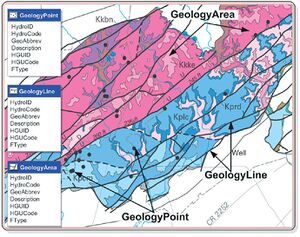
Geology component for representing data from geologic maps
The Geology component conations a set of feature classes for representing data from geologic maps and to integrate geologic data with other groundwater-related datasets.
- GeologyPoint – Points that represent locations such as springs, caves, sinks, and observation points.
- GeologyLine – Line features that describe objects such as faults, contacts, and dikes.
- GeologyArea – Polygon features describing areal features such as rock units and alteration zones.
   GeologyPoint, GeologyLine, and GeologyArea GeologyPoint, GeologyLine, and GeologyArea
|
| Point, line and polygon features
|
| Field name
|
Type
|
Description
|
| HydroID |
Long Integer |
Unique feature identifier in the geodatabase used for creating relationships between classes of the data model.
|
| HydroCode |
Text |
Permanent public identifier of the feature used for relating features with external information systems.
|
| GeoAbbrev |
Text |
Abbreviation of the geologic feature. Used in map legends and labeling.
|
| Description |
Text |
A text description of the feature.
|
| HGUID |
Long Integer |
Hydrogeologic unit identifier. Relates the feature with a hydrogeologic unit.
|
| HGUCode |
Text |
Text code for storing the permanent identification code of hydrogeologic units.
|
| FType |
Text |
Distinguishes between types of geologic features.
|
Borehole data
The Borehole component contains classes for representing 3D information recorded along boreholes. The data can be stored as tabular information related to well features or as 3D point and line features that can be visualized in ArcScene.
- BoreholeLog – Table for representing vertical data along boreholes. Each row in the BoreholeLog table represents a point or interval along the borehole.
- BorePoint – 3D point feature class for representing point data along boreholes
- BoreLine – 3D line feature class for representing interval data along boreholes.
 BoreholeLog BoreholeLog
|
| Table
|
| Field name
|
Type
|
Description
|
| WellID |
Long Integer |
References the HydroID of a Well feature.
|
| RefElev |
Double |
A reference elevation (e.g., land elevation, top of casing) giving the starting elevations for data measured as depth along the borehole.
|
| FromDepth |
Double |
The top elevation of an interval measured as depth along the borehole.
|
| ToDepth |
Double |
The bottom elevation of an interval measured as depth along the borehole.
|
| TopElev |
Double |
Top elevation of an interval represented in absolute elevation units (e.g., feet above mean sea level).
|
| BottomElev |
Double |
Bottom elevation of an interval represented in absolute elevation units (e.g., feet above mean sea level).
|
| ElevUnits |
Text |
Units of elevations stored in the TopElev and BottomElev attributes.
|
| Material |
Text |
Description of strata observed along a borehole. Usually documented in drilling logs and later classified into geologic/hydrogeologic units.
|
| HGUID |
Long Integer |
Hydrogeologic unit identifier. Classifies borehole data into hydrogeologic units defined in the HydrogeologicUnit table.
|
| HGUCode |
Text |
Hydrogeologic unit code. Text for classifying, symbolizing, and labeling hydrogeologic units.
|
| LogType |
Text |
Distinguishes between types of borehole logs (e.g., well completion, hydrostratigraphy).
|
 BorePoint BorePoint
|
| Point Z Feature Class
|
| Field name
|
Type
|
Description
|
| HydroID |
Long Integer |
Unique feature identifier in the geodatabase used for creating relationships between classes of the data model.
|
| HydroCode |
Text |
Permanent public identifier of the feature used for relating features with external information systems.
|
| WellID |
Long Integer |
References the HydroID of a Well feature.
|
| GeoSectionID |
Long Integer |
|
| Material |
Text |
Description of strata observed along a borehole. Usually documented in drilling logs and later classified into geologic/hydrogeologic units.
|
| HGUID |
Long Integer |
Hydrogeologic unit identifier. Classifies borehole data into hydrogeologic units defined in the HydrogeologicUnit table.
|
| HGUCode |
Text |
Hydrogeologic unit code. Text for classifying, symbolizing, and labeling hydrogeologic units.
|
| PointElev |
Double |
Elevation of the BorePoint feature.
|
| FType |
Text |
Distinguishes between types of BorePoint features (e.g., stratigraphic picks, sampling ports).
|
| HorizonID |
Long Integer |
|
 BoreLine BoreLine
|
| Polyline Z Feature Class
|
| Field name
|
Type
|
Description
|
| HydroID |
Long Integer |
Unique feature identifier in the geodatabase used for creating relationships between classes of the data model.
|
| HydroCode |
Text |
Permanent public identifier of the feature used for relating features with external information systems.
|
| WellID |
Long Integer |
References the HydroID of a Well feature.
|
| Matieral |
Text |
Description of strata observed along a borehole. Usually documented in drilling logs and later classified into geologic/hydrogeologic units.
|
| HGUID |
Long Integer |
Hydrogeologic unit identifier. Classifies borehole data into hydrogeologic units defined in the HydrogeologicUnit table.
|
| HGUCode |
Text |
Hydrogeologic unit code. Text for classifying, symbolizing, and labeling hydrogeologic units.
|
| TopElev |
Double |
Top elevation of the BoreLine feature.
|
| BottomElev |
Double |
Bottom elevation of the BoreLine feature.
|
| FType |
Text |
Distinguishes between types of BoreLine features (e.g., well completion, hydrostratigraphy).
|
Hydrostratigraphy
The hydrostratigraphy component represents hydrogeologic units using 2D and 3D features. Classes in the component enable the representation of hydrogeologic models including 2D polygons representing the extent of hydrogeologic units, cross sections, surfaces representing the top and bottom of hydrogeologic units, volume elements. In the Arc Hydro Groundwater data model, the 2D representation of cross-sections is implemented with multiple feature classes, and these are given the “XS2D” prefix (e.g., XS2D_Boreline and XS2D_Panel).
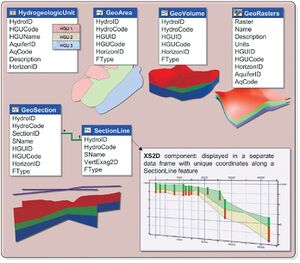
Hydrostratigraphy component
- GeoArea – Polygon feature class for representing the 2D extent of hydrogeologic units or parts of them.
- GeoRasters – Raster catalog for storing rater surfaces. The catalog enables storing rasters within the geodatabase and adding attributes describing raster datasets.
- GeoSection – 3D multipatch feature class representing vertical cross sections.
- GeoVolume – 3D volume objects representing hydrogeologic units.
- HydrogeologicUnit – Table for defining conceptual hydrogeologic units.
- SectionLine – Line feature class for representing 2D section lines.
- XS2D_Catalog – Table for managing XS2D feature classes and their association with SectionLine features.
- XS2D_BoreLine – Polyline feature class for representing vertical borehole data projected on a vertical plane along a section line. Usually, when creating a new cross-section, a set of wells is selected near the line defining the cross-section, and hydrostratigraphic data along the boreholes is projected on the cross-section plane.
- XS2D_Panel – Polygon feature class for representing hydrogeologic units as 2D cross-section "panels." Usually a cross-section will be formed by a set of XS2D_Panel features, each representing a hydrogeologic unit along a section line.
- XS2D_PanelDivider – Polyline feature class representing vertical lines on a cross-section plane, showing the location where a section line changes direction (i.e., the location of vertices of the section line). Panel dividers are used as guides for orientation when viewing the 2D cross-section.
- XS2D_MajorGrid and XS2D_MinorGrid – Polyline feature classes representing grid lines showing the vertical and horizontal dimensions in a 2D cross-section. Major grid lines are typically drawn as vertical and horizontal lines across the cross-section, while minor grid lines are indicated by tick marks along the border of the cross-section.
 GeoArea GeoArea
|
| Polygon Feature Class
|
| Field name
|
Type
|
Description
|
| HydroID |
Long Integer |
Unique feature identifier in the geodatabase used for creating relationships between classes of the data model.
|
| HydroCode |
Text |
Permanent public identifier of the feature used for relating features with external information systems.
|
| HGUID |
Long Integer |
Hydrogeologic unit identifier. Relates GeoArea polygons with more detailed descriptions of hydrogeologic units defined in the HydrogeologicUnit table.
|
| HGUCode |
Text |
Text descriptor of hydrogeologic units used for labeling, symbolization, and queries.
|
| HorizonID |
Long Integer |
Index for describing the depositional sequence of hydrogeologic units.
|
| FType |
Text |
Distinguishes between types of GeoArea features.
|
 GeoRasters GeoRasters
|
| Raster Catalog
|
| Field name
|
Type
|
Description
|
| Name |
Text |
Generic raster catalog attribute (created automatically when you create a raster catalog) used to store the name of a raster dataset.
|
| Description |
Text |
Text descriptor of the raster (e.g., formation top, formation bottom).
|
| RasUnits |
Text |
The raster units (e.g., feet above mean sea level).
|
| HGUID |
Long Integer |
Hydrogeologic unit identifier. Relates rasters in the catalog with more detailed descriptions of hydrogeologic units defined in the HydrogeologicUnit table.
|
| HGUCode |
Text |
Text descriptor of the hydrogeologic unit used for labeling, symbolization, and queries.
|
| HorizonID |
Long Integer |
Index for describing the depositional sequence of hydrogeologic units.
|
| AquiferID |
Long Integer |
Relates rasters with Aquifer features. The AquiferID attribute of a GeoRaster relates to the HydroID of an Aquifer feature.
|
| AqCode |
Text |
Aquifer code. Text descriptor of aquifers used for labeling, symbolization, and querying.
|
| Clip |
Long Integer |
|
| Fill |
Long Integer |
|
 GeoSection GeoSection
|
| 3D MultiPatch Feature Class
|
| Field name
|
Type
|
Description
|
| HydroID |
Long Integer |
Unique feature identifier in the geodatabase used for creating relationships between classes of the data model.
|
| HydroCode |
Text |
Permanent public identifier of the feature used for relating features with external information systems.
|
| SectionID |
Long Integer |
Equal to the HydroID of a SectionLine feature. Relates GeoSection features with SectionLine features.
|
| SName |
Text |
Section name. Text descriptor of the section line for labeling, symbolization, and queries (e.g., A-A’).
|
| HGUID |
Long Integer |
Hydrogeologic unit identifier. Relates GeoSection features with more detailed descriptions of hydrogeologic units defined in the HydrogeologicUnit table.
|
| HGUCode |
Text |
Text descriptor of the hydrogeologic unit used for labeling, symbolization, and queries.
|
| FromWell |
Long Integer |
|
| ToWell |
Long Integer |
|
| FType |
Text |
Distinguishes between types of GeoSection features.
|
| HorizonID |
Long Integer |
Index for describing the depositional sequence of hydrogeologic units.
|
 GeoVolume GeoVolume
|
| 3D MultiPatch Feature Class
|
| Field name
|
Type
|
Description
|
| HydroID |
Long Integer |
Unique feature identifier in the geodatabase used for creating relationships between classes of the data model.
|
| HydroCode |
Text |
Permanent public identifier of the feature used for relating features with external information systems.
|
| HGUID |
Long Integer |
Hydrogeologic unit identifier. Relates GeoVolume features with more detailed descriptions of hydrogeologic units defined in the HydrogeologicUnit table.
|
| HGUCode |
Text |
Text descriptor of the hydrogeologic unit used for labeling, symbolization, and queries.
|
| HorizonID |
Long Integer |
Index for describing the depositional sequence of hydrogeologic units.
|
| FType |
Text |
Distinguishes between types of GeoVolume features.
|
 HydrogeologicUnit HydrogeologicUnit
|
| Table
|
| Field name
|
Type
|
Description
|
| HydroID |
Long Integer |
Unique identifier in the geodatabase used for creating relationships between classes of the data model. Used to relate between hydrogeologic units defined in the table and spatial features within the hydrostratigraphy component.
|
| HGUCode |
Text |
Hydrogeologic unit code. The permanent identification code of hydrogeologic units, used to establish a linkage with external information systems.
|
| HGUName |
Text |
Text descriptor of hydrogeologic units used for labeling and symbolization.
|
| AquiferID |
Long Integer |
Aquifer identifier for grouping hydrogeologic units. AquiferID is also used to relate hydrogeologic units in the table with Aquifer features.
|
| AqCode |
Text |
Aquifer code. Text descriptor of the aquifer used for labeling, symbolization, and querying.
|
| Description |
Text |
Text for storing detailed descriptions of hydrogeologic units.
|
| HorizonID |
Long Integer |
Index for describing the depositional sequence of hydrogeologic units.
|
 SectionLine SectionLine
|
| Line Feature Class
|
| Field name
|
Type
|
Description
|
| HydroID |
Long Integer |
Unique feature identifier in the geodatabase used for creating relationships between classes of the data model.
|
| HydroCode |
Text |
Permanent public identifier of the feature used for relating features with external information systems.
|
| SName |
Text |
Section name. Text descriptor of the section line for labeling, symbolization, and queries (e.g., A-A’).
|
| VertExag2D |
Double |
Vertical exaggeration that will be applied when creating XS2D features (see section on representing vertical cross sections in 2D).
|
| FType |
Text |
Distinguishes between types of SectionLine features.
|
 XS2D_Catalog XS2D_Catalog
|
| Table
|
| Field name
|
Type
|
Description
|
| SectLineFC |
Text |
Name of the SectionLine feature class containing the referenced SectionLine feature.
|
| SectionID |
Long Integer |
HydroID of the associated SectionLine feature.
|
| SName |
Text |
Name of the associated SectionLine feature.
|
| XS2D_FC |
Text |
Name of the XS2D feature class.
|
| XS2DType |
Text |
Role that the XS2D feature class plays in the cross section (e.g., Boreline, Panel, Grid, etc.).
|
 XS2D_BoreLine XS2D_BoreLine
|
| Polyline Feature Class
|
| Field name
|
Type
|
Description
|
| HydroID |
Long Integer |
Unique feature identifier in the geodatabase used for creating relationships between classes of the data model.
|
| HydroCode |
Text |
Permanent public identifier of the feature used for relating features with external information systems.
|
| WellID |
Long Integer |
HydroID of the associated Well feature.
|
| TopElev |
Double |
Top elevation of the XS2D_BoreLine feature.
|
| BottomElev |
Double |
Bottom elevation of the XS2D_BoreLine feature.
|
| Material |
Text |
Description of strata observed along a borehole. Usually documented in drilling logs and later classified into geologic/hydrogeologic units.
|
| HGUID |
Long Integer |
Hydrogeologic unit identifier. Is equal to the HydroID of a hydrogeologic unit defined in the HydrogeologicUnit table.
|
| HGUCode |
Text |
Text descriptor of the hydrogeologic unit used for labeling, symbolization, and queries.
|
| Offset |
Double |
Distance from the well related to the XS2D_BoreLine feature to the nearest point on the section line (distance units are the same as the units of the SectionLine feature class).
|
| Measure |
Double |
Distance along the section line to the Well feature associated with the XS2D_BoreLine feature. The distance is measured from the starting point of the section line to the point on the section line closest to the Well feature.
|
| IsLeft |
Long Integer |
TRUE if the Well feature associated with the XS2D_BoreLine is on the left side of a section line in the direction of digitization. FALSE if it is on the right side.
|
| FType |
Text |
Distinguishes between types of XS2D_BoreLine features.
|
 XS2D_Panel XS2D_Panel
|
| Polygon Feature Class
|
| Field name
|
Type
|
Description
|
| HydroID |
Long Integer |
Unique feature identifier in the geodatabase used for creating relationships between classes of the data model.
|
| HydroCode |
Text |
Permanent public identifier of the feature used for relating features with external information systems.
|
| HGUID |
Long Integer |
Hydrogeologic unit identifier. Is equal to the HydroID of a hydrogeologic unit defined in the HydrogeologicUnit table.
|
| HGUCode |
Text |
Text descriptor of the hydrogeologic unit used for labeling, symbolization, and queries.
|
| FType |
Text |
Distinguishes between types of XS2D_Panel features.
|
 XS2D_PanelDividier XS2D_PanelDividier
|
| Polyline Feature Class
|
| Field name
|
Type
|
Description
|
| HydroID |
Long Integer |
Unique feature identifier in the geodatabase used for creating relationships between classes of the data model.
|
| HydroCode |
Text |
Permanent public identifier of the feature used for relating features with external information systems.
|
| Measure |
Double |
Distance along the section line to the vertex of the line where the direction changes. The distance is measured from the starting point of the section line to the point of direction change.
|
 XS2D_MajorGrid and XS2D_MinorGrid XS2D_MajorGrid and XS2D_MinorGrid
|
| Polyline Feature Class
|
| Field name
|
Type
|
Description
|
| HydroID |
Long Integer |
Unique feature identifier in the geodatabase used for creating relationships between classes of the data model.
|
| HydroCode |
Text |
Permanent public identifier of the feature used for relating features with external information systems.
|
| GridValue |
Double |
Elevation or measure (distance along section line) value used for labeling grid lines, using the same distance units as the coordinate system of the SectionLine feature associated with the cross section.
|
| IsVertical |
Long Integer |
TRUE if the grid line is vertical; FALSE if it is horizontal.
|
Time Series
The Time Series component provides a new design for dealing with temporal data within Arc Hydro. The new design provides better support for utilizing multiple representations of time series data and a new table to describe time series variables.
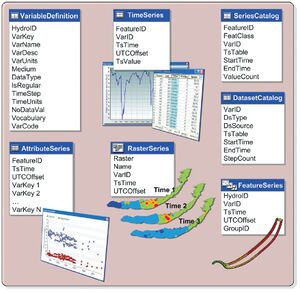
The Arc Hydro Groundwater Temporal Component.
- AttributeSeries – Table for archiving time-series data where multiple variables are indexed with the same feature and time.
- DatasetCatalog – Table for indexing time-series datasets.
- FeatureSeries – Collections of features indexed by time representing a series of geometries varying in location or shape.
- RasterSeries – Raster catalog for storing collections of raster datasets indexed by time.
- SeriesCatalog – Table for indexing and summarizing time series stored in the TimeSeries table.
- TimeSeries – Table for storing single-variable time series.
- VariableDefinition – Table for defining temporal variables.
 AttributeSeries AttributeSeries
|
| Table
|
| Field name
|
Type
|
Description
|
| FeatureID |
Long Integer |
Unique feature identifier. Is equal to the HydroID of the feature associated with the time series value.
|
| TsTime |
Date |
Time stamp specifying the date and time associated with the time series value.
|
| UTCOffset |
Long Integer |
Number of hours the time coordinate system used to define TsTime is displaced from Coordinated Universal Time.
|
| VarKey 1 |
Double |
For a given value field, the field name indicates the variable whose TSValues are stored in that field. This variable is linked to the VariableDefinition table via the VarKey field.
|
| VarKey 2 |
Double |
For a given value field, the field name indicates the variable whose TSValues are stored in that field. This variable is linked to the VariableDefinition table via the VarKey field.
|
| ... |
... |
... |
|
| VarKey N |
Double |
For a given value field, the field name indicates the variable whose TSValues are stored in that field. This variable is linked to the VariableDefinition table via the VarKey field.
|
 DatasetCatalog DatasetCatalog
|
| Table
|
| Field name
|
Type
|
Description
|
| VarID |
Long Integer |
Numerical identifier for the variable within the geodatabase. Matches the HydroID of the associated record in the VariableDefinition table.
|
| DsType |
Text |
Type of time-series dataset described, e.g., RasterSeries, FeatureSeries, Feature Layer.
|
| DsSource |
Text |
Name of the time-series dataset described.
|
| TsTable |
Text |
Name of the time-series table that contains time-series values, used in cases where features are associated with a time series of values stored in a separate table (e.g., wells related with water levels, or polygons related with precipitation)
|
| StartTime |
Date |
Start date/time of the series.
|
| EndTime |
Date |
End date/time of the series.
|
| StepCount |
Long Integer |
Number of unique time steps in the time-series dataset.
|
   FeatureSeries FeatureSeries
|
| Collection of Feature Classes
|
| Field name
|
Type
|
Description
|
| HydroID |
Long Integer |
Unique feature identifier in the geodatabase used for creating relationships between classes of the data model.
|
| VarID |
Long Integer |
Numerical identifier for the variable within the geodatabase. Matches the HydroID of the associated record in the VariableDefinition table.
|
| TsTime |
Date |
Time stamp specifying the date and time associated with the feature.
|
| UTCOffset |
Long Integer |
Number of hours the time coordinate system used to define TsTime is displaced from Coordinated Universal Time.
|
| GroupID |
Long Integer |
Index for grouping a set of features into a “track” showing the change of a feature’s shape, location, or both.
|
 RasterSeries RasterSeries
|
| Raster Catalog
|
| Field name
|
Type
|
Description
|
| Name |
Text |
Generic attribute (created automatically when you create a raster catalog) used to store the name of a raster dataset.
|
| VarID |
Long Integer |
Numerical identifier for the variable within the geodatabase. Matches the HydroID of the associated record in the VariableDefinition table.
|
| TsTime |
Date |
Time stamp specifying the date and time associated with the raster.
|
| UTCOffset |
Long Integer |
Number of hours the time coordinate system used to define TsTime is displaced from Coordinated Universal Time.
|
 SeriesCatalog SeriesCatalog
|
| Table
|
| Field name
|
Type
|
Description
|
| FeatureID |
Long Integer |
Unique feature identifier. Is equal to the HydroID of the feature associated with the time series summarized in the catalog.
|
| FeatClass |
Text |
Name of the feature class to which the related feature belongs.
|
| VarID |
Long Integer |
Numerical identifier for the variable within the geodatabase. Matches the HydroID of the associated record in the VariableDefinition table.
|
| TsTable |
Text |
Table containing the time series records.
|
| StartTime |
Date |
The start date/time value of the series.
|
| EndTime |
Date |
The end date/time value of the series.
|
| ValueCount |
Long Integer |
Number of time-series values in the series.
|
 TimeSeries TimeSeries
|
| Table
|
| Field name
|
Type
|
Description
|
| FeatureID |
Long Integer |
Unique feature identifier. Is equal to the HydroID of the feature associated with the time series value.
|
| VarID |
Long Integer |
Numerical identifier for the variable within the geodatabase. Matches the HydroID of the associated record in the VariableDefinition table.
|
| TsTime |
Date |
Time stamp specifying the date and time associated with the time series value.
|
| UTCOffset |
Double |
Number of hours the time coordinate system used to define TsTime is displaced from Coordinated Universal Time.
|
| TsValue |
Double |
Numerical value of the variable at the given location and time.
|
 VariableDefinition VariableDefinition
|
| Table
|
| Field name
|
Type
|
Description
|
| HydroID |
Long Integer |
Unique numerical identifier for the row within the geodatabase. Matches VarID in related tables.
|
| VarKey |
Text |
Unique text ID for a variable, used when a variable is indexed in an attribute series table via field names.
|
| VarName |
Text |
The name of the variable.
|
| VarDesc |
Text |
The description of the variable.
|
| Vocabulary |
Text |
Name of the list of variables in which a particular VarCode is defined (e.g., USGS NWIS).
|
| VarCode |
Text |
Public identifier for a variable (e.g., "00060" for discharge in USGS NWIS).
|
| Medium |
Text |
Medium in which the variable is observed or occurs (e.g., "Groundwater“)
|
| VarUnits |
Text |
Units of measure for the variable.
|
| DataType |
Text |
Describes whether the time series contains instantaneous measurements, cumulative values, etc.
|
| IsRegular |
Short Integer |
Integer field that stores 1 (TRUE) if the time series values are regularly spaced in time, or 0 (FALSE) if the time series is irregular.
|
| TimeStep |
Long Integer |
For regular time series, the number of TimeUnits between each occurrence of a time series value.
|
| TimeUnits |
Text |
For regular time series, the time unit used to describe the length of time between occurrences of a time series value.
|
| NoDataVal |
Long Integer |
Numerical value used to indicate a "No Data Value" (e.g., a missing value) in the time series table.
|
Simulation
The AHGW simulation feature dataset is a set of vector feature classes that can represent common modeling objects and it is designed to allow for representation of finite element and finite difference systems in a GIS. The simulation feature dataset includes four feature classes: Boundary, Cell2D, Cell3D, Node2D, and Node3D. These feature classes enable storage and representation of model inputs and outputs related to the simulation objects.
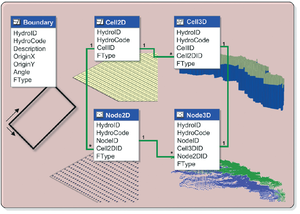
The Arc Hydro Groundwater Simulation Feature Dataset.
- Boundary – Polygon feature class that represents the two-dimensional extent of a model. It is not an essential part of the model representation but it can be useful to illustrate the location of the simulation model to support a simple spatial reference or database query.
- Cell2D – Polygon feature class used to represent cells or elements associated with two-dimensional simulation models or a single layer of a three-dimensional model.
- Cell3D – Multipatch feature class for representing three-dimensional cells and elements of simulation models.
- Node2D – 2D Point feature class that represents nodes in a 2D model grid/mesh or the nodes in a single layer of a 3D model grid/mesh.
- Node3D – 3D Point feature class that represents nodes in a model grid/mesh.
 Boundary Boundary
|
| Polygon Feature Class
|
| Field name
|
Type
|
Description
|
| HydroID |
Long Integer |
Unique feature identifier in the geodatabase used for creating relationships between classes of the data model.
|
| HydroCode |
Text |
Permanent public identifier of the feature used for relating features with external information systems.
|
| ModelDesc |
Text |
A text descriptor of the model.
|
| OriginX |
Double |
X coordinate of the model origin.
|
| OriginY |
Double |
Y coordinate of the model origin.
|
| Angle |
Double |
The model angle of rotation.
|
| FType |
Text |
Distinguishes between types of Boundary features.
|
 Cell2D Cell2D
|
| Polygon Feature Class
|
| Field name
|
Type
|
Description
|
| HydroID |
Long Integer |
Unique feature identifier in the geodatabase used for creating relationships between classes of the data model.
|
| HydroCode |
Text |
Permanent public identifier of the feature used for relating features with external information systems.
|
| CellID |
Long Integer |
Index of the cell within the numbering scheme used for an individual layer of the computational grid.
|
| FType |
Text |
Distinguishes between types of Cell2D features.
|
 Cell3D Cell3D
|
| 3D MultiPatch Feature Class
|
| Field name
|
Type
|
Description
|
| HydroID |
Long Integer |
Unique feature identifier in the geodatabase used for creating relationships between classes of the data model.
|
| HydroCode |
Text |
Permanent public identifier of the feature used for relating features with external information systems.
|
| CellID |
Long Integer |
Global index of the cell within the numbering scheme used for the computational grid.
|
| Cell2DID |
Long Integer |
Index relating Cell3D features with a Cell2D feature. The Cell2DID of a Cell3D feature is equal to the CellID of a Cell2D feature.
|
| FType |
Text |
Distinguishes between types of Cell3D features.
|
 Node2D Node2D
|
| Point Feature Class
|
| Field name
|
Type
|
Description
|
| HydroID |
Long Integer |
Unique feature identifier in the geodatabase used for creating relationships between classes of the data model.
|
| HydroCode |
Text |
Permanent public identifier of the feature used for relating features with external information systems.
|
| NodeID |
Long Integer |
Index of the node within the numbering scheme used for an individual layer of the computational grid.
|
| Cell2DID |
Long Integer |
Index relating Node2D features with a Cell2D feature.
|
| FType |
Text |
Distinguishes between types of Node2D features.
|
 Node3D Node3D
|
| 3D Point Feature Class
|
| Field name
|
Type
|
Description
|
| HydroID |
Long Integer |
Unique feature identifier in the geodatabase used for creating relationships between classes of the data model.
|
| HydroCode |
Text |
Permanent public identifier of the feature used for relating features with external information systems.
|
| NodeID |
Long Integer |
Global index of the node within the numbering scheme used for the computational grid.
|
| Cell3DID |
Long Integer |
Index relating Node3D features with a Cell3D feature. The Cell3DID of a Node3D feature is equal to the CellID of a Cell3D feature.
|
| Node2DID |
Long Integer |
Index relating Node3D features with a Node2D feature. The Node2DID of a Node3D feature is equal to the NodeID of a Node2D feature.
|
| FType |
Text |
Distinguishes between types of Node3D features.
|
See also

